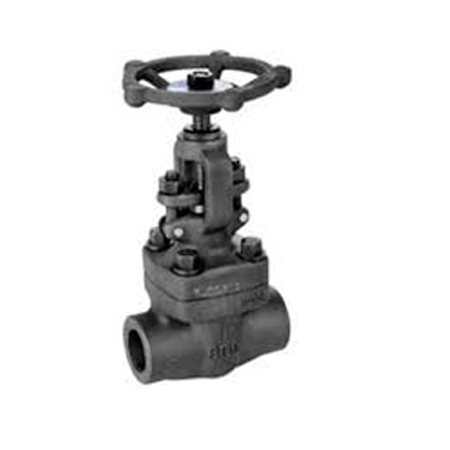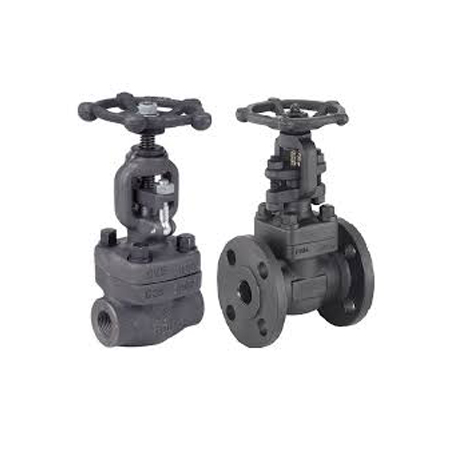We are Manufacturer, Supplier, Exporter of Forged Gate Valves, Flanged End, Screwed End, Socket End, Butt
Weld End Forged Gate Valves, Industrial Valves, Industrial Actuated Valves, Industrial Valve Actuators,
Industrial Valve Accessories and our setup is situated in Belgaum, Karnataka, India.
We majorly target
customers from ALL OVER INDIA.
These are used in Oil And Gas Industry, Petrochemical Industries, Chemical Processing Industries, Power Generation Industries, Water Treatment, Wastewater Treatment, Water Distribution And Utilities, Pulp And Paper Industries, HVAC Systems, Food Industries, Beverage Industries, Steamline And Boilers, Pharmaceutical Industries, Manufacturing Industries, Glass Manufacturing Industry, Power Plant, Chemical Industries.
| Sizes in mm(Inch) | Pressure Rating |
|---|---|
| Screwed, Socket & Butt Weld Ends | |
| 15 (1/2") to 50 (2") | Class 800 & 1500 |
| 15 (1/2") to 25 (1") | Class 2500 |
| Flanged Ends ( Weldon Flanges) | |
| 15 (1/2") to 50 (2") | Class 150, 300 & 600 |
| Design Std | API 602, BS 5232 |
| Face to Face | ASME B16.10 |
| Testing Std. | API 598/EN 1266-1 |
| Body & Bonnet | A105, F11, F22, F5, F9, F304 & F316 |
| Wedge | CA15, CF8, CF8M |
| Stem | 410, 304, 316 |
| Seat | 410, 304, 316 |
| End Connection | Flanged, Screwed, Socket weld Ends |
| End Detail | For SE – BS:21 (Parallel/ Taper) / ASME B1.20.1 (NPT) Threads, SWE B16.11 |
Full Flow Capability: When fully open, gate valves provide a straight-through, unobstructed flow path. This minimizes pressure drop and allows for maximum flow capacity, which is advantageous in applications requiring minimal resistance.
Positive Shut-Off: Gate valves offer excellent shut-off capabilities. The gate or wedge completely seals against the seats when closed, providing a tight seal and preventing leakage.
Durability: Gate valves are built to handle high pressures and temperatures. They are durable and robust, making them suitable for demanding applications in industries such as oil and gas, water treatment, and power generation.
Minimal Flow Disturbance: Because gate valves have a linear motion and do not obstruct the flow path when fully open, they create minimal turbulence and flow disturbance, which can be important in certain processes.
Versatility: Gate valves can be used in a wide range of applications, including both on/off and throttling services. They are suitable for fluids, gases, and even slurries, depending on the valve design and material.
Design Variations: Gate valves come in various designs, including rising stem, non-rising stem, and double-disc configurations. This variety allows them to be tailored to specific installation and operational needs.
Manual Operation: Gate valves are typically operated manually via a handwheel or gear mechanism. This can be advantageous for applications where manual control is preferred.
Long Service Life: With proper maintenance, gate valves can have a long service life. Their robust construction and ability to handle high pressures contribute to their longevity.
Seating Options: Gate valves can be equipped with different types of seating materials, such as metal or resilient (soft) seats, to accommodate various operating conditions and requirements for sealing.
Flow Regulation: While gate valves are primarily used for on/off control, they can also be used for throttling flow, although they are generally less effective for precise flow control compared to some other valve types.
Low Friction Loss: When fully open, gate valves have low friction loss due to their design, which allows them to provide an efficient flow path.
Body Materials: Gate valves are available in a range of materials, including cast iron, steel, stainless steel, and bronze, making them adaptable to different media and operating conditions.
Non-Rising Stem Option: In applications where vertical space is limited, non-rising stem gate valves can be used. In these valves, the stem does not move upwards but rather rotates within the valve body.



